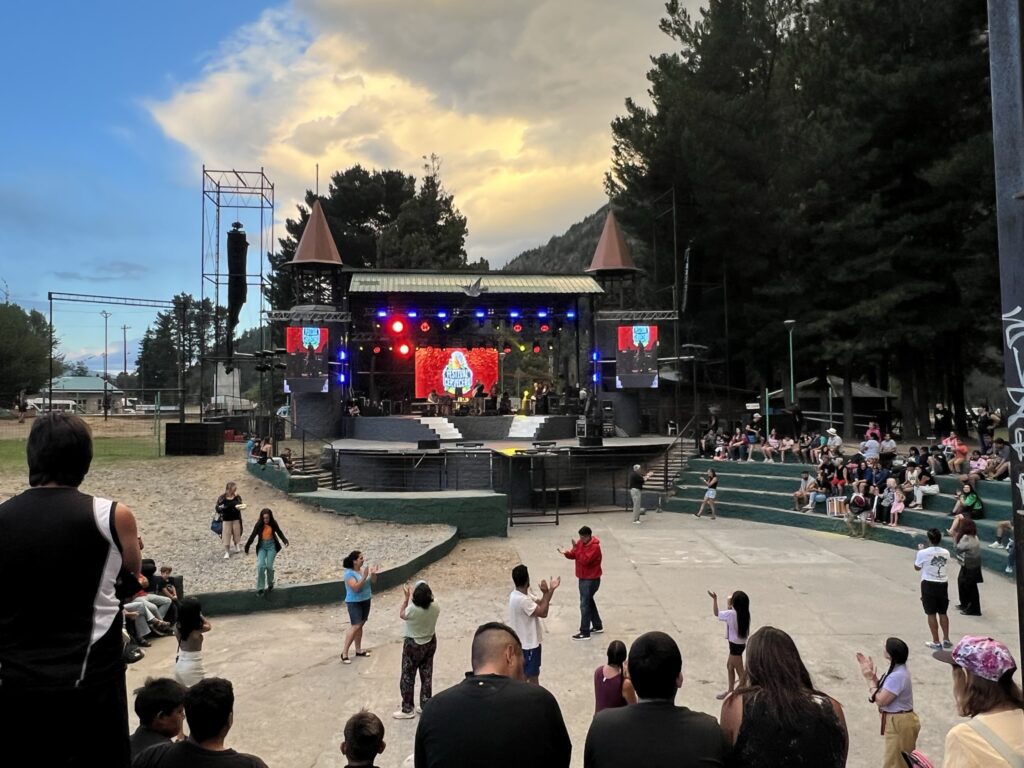The Argentina Lake District is made up of hundreds of lakes in Northern Patagonia. El Bolson, San Carlos de Bariloche, and San Martin de Los Andes offer a great variety of options to explore this natural beauty.
Best Thing I Ate This Week
Goulash con Spatzle at Restaurant Familia Weiss
Restauant Familia Weiss resembles a traditional German/Austrian restaurant in design and menu inspiration. When we entered, we were greeted by a friendly older woman who made us feel right at home. We later learned that it was abuela (grandma) Weiss still working at her family restaurant.

To start we had a Picada Chica Familia Weiss (charcuterie board) and were able to sample smoked cheeses, fish, deer from the region. My main dish of goulash con spatzle was a delicious beef stew with a red wine and paprika sauce served over spatzle. The combination of flavors and interior decorations made me feel transported to Europe, although the Argentine flag at the bar reminded me I was still in South America.


An Interesting Fact I Learned
Argentina had three waves of Germanic immigration
There is a misconception that the majority of Germans that came to Argentina were former Third Reich officials. While it is true that some prominent Nazis did flee to Argentina after World War 2, there had already been 2 major waves of Germanic immigration prior to them. A guide in San Carlos de Bariloche offers a walking tour to examine this controversial topic and share more about the history.

During the 1840s Germanic people were coming to the Americas for land and democracy. While millions settled in the U.S.A., hundreds of thousands came to Argentina. At that time they settled in the Northeast of Argentina. (Patagonia was not yet part of Argentina at the time and was still land owned by indigenous populations.) Eventually, German settlers from Patagonia Chile came across the Andes and founded San Carlos de Bariloche in collaboration with the Argentine government.
The second wave of immigration occurred after World War 1. Again, people were leaving to find prosperity in the Americas due to the economic crisis after World War 1. Many were attracted to San Carlos de Bariloche, given its comparable climate and landscape to Germany. As the Third Reich took power in Germany, many Jewish immigrants came to Argentina, which is why it has the 5th largest Jewish population today, excluding Israel. At the same time, Germany was trying to pay immigrants to come back to reignite their economy, and some people from the first wave did return to Europe.

The third wave of immigration to Argentina came after World War 2 but was made up of various countries trying to escape the destruction of the war for a better life in the Americas. Hidden amongst those million people were an estimated 180 Nazi soldiers and officers. The most infamous were Joseph Mengele who escaped capture in Argentina before dying outside of Sao Paulo, and Adolf Eichmann who was captured in Buenos Aires by the Mossad then brought to Israel for trail.
My Travel Tip of the Week
National Parks are great for relaxing in addition to hiking
Some of our favorite experiences have been hiking in national parks to experience the immense beauty of nature up close. While in San Carlos de Bariloche, there was an all day tour to Los Arrayanes National Park and Isla Victoria in Nahuel Huapi National Park in the Argentina Lake District. Each park had a small hike through nature to learn more about the various trees and plants.



However, the majority of the tour was spent relaxing in the park and on the water. A scenic ride across Lago Nahuel Huapi included incredible views of the Andes rising above the bright blue lake. While on Isla Victoria, there was a beach where we had time to soak in the sun or cool down in the water. It was a perfect way to enjoy the national parks at a different pace than we had been doing recently but was still a wonderful experience.
My Additional Anecdote This Week
Traveling is a great time to try new activities or do favorite ones in a new setting
Kayaking in Patagonia is a popular activity given the pristine waters and beautiful surrounding views. We previously had done kayaking leisurely in the U.S. and wanted to try in Lago Puelo National Park so we could see more of the lake in a different way. Our guide Alberto was a seasoned kayaker that lived in the area and helped us with the correct technique. It turned out to be a particularly windy and wavy day, which made for a more challenging experience than we expected. At one point we received instructions for what to do if the boat flipped, but we made it through the toughest stretch without issues and were rewarded with incredible views.

After the kayaking, we stopped in the town of Lago Puelo, which was hosting Cervecero del Bosque (a brewery festival) to highlight the local brewers from this forested region of Argentina. We enjoyed sampling local products and decided to spend the evening at this small town festival. It was a great experience to try a frambuesa beer which was a beer made with the local raspberries. Also, we watched musical and dance performances that were traditional to the region. At the end of the night, local guachos completed their asado de carne (large barbeque tradition in Argentina), and we enjoyed a delicious beef dinner with the others from the small town.


